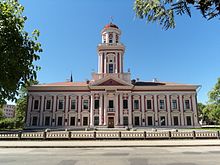Jelgava Gymnasium

Jelgava Gymnasium or Academia Petrina is the oldest higher educational establishment in Latvia.[1] Based on an idea by , it was established in Mitau, capital of the Duchy of Courland and Semigallia, by Duke Peter von Biron in 1775. The duke wanted to attract professors like Immanuel Kant and Johan Gottfried Herder, but they refused.
After the partitions of the Polish–Lithuanian Commonwealth, Jelgava became part of the Russian Empire and the gymnasium unsuccessfully petitioned to become a university.[2] Nevertheless, it became an important cultural hub not only for Latvians, but also Lithuanians.[3] Many famous professors had lectured in Academia Petrina for example Johann Benjamin Koppe (1775), Johann August von Starck (1777–1781) and (1775–1811).
During World War I, the school was evacuated to Taganrog in Rostov Oblast while its 42,000-volume library was burned by troops of Pavel Bermondt-Avalov.[4] During World War II, the historical school building was almost completely destroyed, therefore school was reestablished in new premises. The original building was later restored and now functions as the Jelgava History and Art Museum.
Name[]
- 1775 Academia Petrina[5]
- Gymnasium Petrinum[6]
- since 1837: official name in German Gouvernements-Gymnasium
- 1934 to 1940: Hercoga Pētera ģimnāzija (Herzog-Peter-Gymnasium)[7]
- after 1945: Jelgavas 1. vidusskola (Jelgavan Secondary School Nr. 1)
- 15. August 1991: 1. Gymnasium
- 2012: Jelgavas Tehnoloģiju vidusskola (Technical Secondary School Jelgava)
History[]
The establishment of the academy was based on an idea by : "But the whole province owes him excellent thanks for the effective part, which he took at the foundation of the Mitauian Gymnasium. He was actually the one who persuaded Duke Peter to do so; it was he who corresponded with Sulzern regarding the plan to be drawn up and because of the appointment of the first teachers and he who prescribed the books for the library and the instruments for the observatory; just as he also continuously participated in the perfection of the institute until his death". [8]
The intention was to establish a complete university with all four faculties in Mitau. This plan was rejected because of Kurland's dependence on Catholic-Polish rule. Under the law of Poland a university could not be founded without the consent and confirmation of the Pope, and it was unclear whether and when the permission by the papal curia to establish a Protestant theological faculty could have been obtained. Therefore, this intention was abandoned and it was decided to found an academic gymnasium which - half school, half university - should enjoy all the rights of a university, with the exception of the privilege of granting academic dignity. [9]
People[]
Famous students[]
| Name | Birth | Death | Later occupation |
|---|---|---|---|
| Jānis Čakste | 1859 | 1927 | President of Latvia |
| Alberts Kviesis | 1881 | 1944 | President of Latvia |
| Antanas Smetona | 1874 | 1944 | President of Lithuania |
| Ernestas Galvanauskas | 1882 | 1967 | Prime Minister of Lithuania |
| Mykolas Sleževičius | 1882 | 1939 | Prime Minister of Lithuania |
| Krišjānis Barons | 1835 | 1923 | Latvian folklorist |
| Kārlis Mīlenbahs | 1853 | 1916 | Latvian philologist |
| Wincenty Lutosławski | 1863 | 1954 | Polish philosopher |
| 1822 | 1896 | Curonian field marshal | |
| 1774 | 1826 | Baltic German poet |
Teachers[]
| Name | Birth | Death | Occupation at the school |
|---|---|---|---|
| 1746 | 1802 | Jurisprudence | |
| Johann Benjamin Koppe | 1750 | 1791 | 1775, Greek language |
| Johann August von Starck | 1741 | 1816 | 1777–1781, Philosophy |
| 1745 | 1811 | 1775–1811 mathematics | |
| 1743 | 1790 | physics and natural history | |
| 1717 | 1779 | 1776–1777 | |
| 1747 | 1811 | 1775–1789 | |
| 1739 | 1798 | 1775–1798 | |
| 1733 | 1803 | 1775–1798 | |
| 1733 | 1805 | ||
| Johann Gottlieb von Groschke | 1760 | 1828 | natural history and chemistry |
| 1786 | 1857 | 1817–1837 | |
| 1813 | 1877 | French | |
| Magnus Georg Paucker | 1787 | 1855 | 1813–1855 mathematics und astronomy |
References[]
- ^ Peck, Bryan T. (24 January 2019). "Education, the Baltic States and the EU". Nova Publishers. Retrieved 24 January 2019 – via Google Books.
- ^ Vihalemm, Rein (30 September 2001). "Estonian Studies in the History and Philosophy of Science". Springer Science & Business Media. Retrieved 24 January 2019 – via Google Books.
- ^ Sabaliunas, Leonas; Sabaliūnas, Leonas (24 January 1990). "Lithuanian Social Democracy in Perspective, 1893–1914". Duke University Press. Retrieved 24 January 2019 – via Google Books.
- ^ Stam, David H. (24 January 2019). "International Dictionary of Library Histories". Taylor & Francis. Retrieved 24 January 2019 – via Google Books.
- ^ "Katalog der Deutschen Nationalbibliothek". portal.dnb.de. Retrieved 24 January 2019.
- ^ 'Universitäten im östlichen Mitteleuropa: Zwischen Kirche, Staat und Nation', S. 43 https://books.google.com/books?isbn=3486845462
- ^ "Katalog der Deutschen Nationalbibliothek". portal.dnb.de. Retrieved 24 January 2019.
- ^ , bearbeitet von Johann Friedrich von Recke, , Dritter Band, L-R, Mitau 1831, S. 461–463 [1]
- ^ "SITZUNGSBERICHTE JAHRESBERICHTE 1935/1936 DER KURZEMER (KURLÄNDISCHEN) GESELLSCHAFT FÜR LITERATUR UND KUNST – PDF". docplayer.org. Retrieved 24 January 2019.
External links[]
- 1775 establishments in Europe
- Schools in Latvia
- 18th-century establishments in Latvia
- Duchy of Courland and Semigallia
- Latvia stubs
- Europe education stubs
